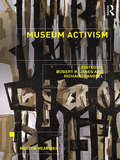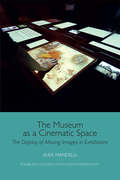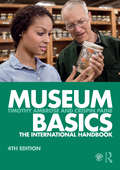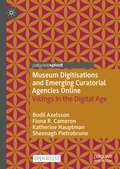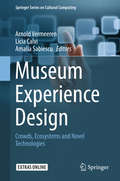- Table View
- List View
The Museum: A Reference Guide
by Michael S. SharpiroThis critical bibliography of museum studies comprises an organized collection of essays on the various types of museums--art, natural history, history, science and technology, and folk--and on general aspects--collections, education, exhibitions, etc.--that cut across the media. Most of the essays are cogent, substantial if not comprehensive, and clear. The editor has taken care to see that they follow a similar format of historical essay followed by a full bibliography of items discussed. Library JournalAs the number of museums in the United States has grown to more than 6500 in this century, the museum profession has experienced similar growth. In addition to academic training and accreditation programs in the field, an expanding body of literature on museum history, philosophy, and functions has evolved, little of which has received the critical attention it deserves. This reference volume serves as an up-to-date guide to this wealth of literature, identifying and evaluating works that introduce the general reader, the museum studies student, and the beginning professional to the history, philosophy, and functions of museums.The volume presents a series of informative, historical outlines and critical bibliographic essays on all aspects of museum history, philosophy, and functions. Contributors treat such subjects as art museums, natural history museums, science and technology museums, history museums, collections, exhibition, education and interpretation, and the public and museums. Each chapter consists of an introductory historical narrative, a survey of sources, and a bibliographic checklist that contains cited and additional sources. A set of appendices include a geographically organized bibliography of museum directories, a guide to archives and special collections, and a selective list of museum-related periodicals. The book concludes with a comprehensive general subject index. This work will be an important reference tool for museum professionals and cultural historians, as well as for courses in museum studies. It will also be a valuable addition to both academic and public libraries.
Museum Activism (Museum Meanings)
by Robert R. Janes Richard SandellOnly a decade ago, the notion that museums, galleries and heritage organisations might engage in activist practice, with explicit intent to act upon inequalities, injustices and environmental crises, was met with scepticism and often derision. Seeking to purposefully bring about social change was viewed by many within and beyond the museum community as inappropriately political and antithetical to fundamental professional values. Today, although the idea remains controversial, the way we think about the roles and responsibilities of museums as knowledge based, social institutions is changing. Museum Activism examines the increasing significance of this activist trend in thinking and practice. At this crucial time in the evolution of museum thinking and practice, this ground-breaking volume brings together more than fifty contributors working across six continents to explore, analyse and critically reflect upon the museum’s relationship to activism. Including contributions from practitioners, artists, activists and researchers, this wide-ranging examination of new and divergent expressions of the inherent power of museums as forces for good, and as activists in civil society, aims to encourage further experimentation and enrich the debate in this nascent and uncertain field of museum practice. Museum Activism elucidates the largely untapped potential for museums as key intellectual and civic resources to address inequalities, injustice and environmental challenges. This makes the book essential reading for scholars and students of museum and heritage studies, gallery studies, arts and heritage management, and politics. It will be a source of inspiration to museum practitioners and museum leaders around the globe.
Museum Activism: Activism And Agency In The Museum (Museum Meanings)
by Robert R. Janes Richard SandellOnly a decade ago, the notion that museums, galleries and heritage organisations might engage in activist practice, with explicit intent to act upon inequalities, injustices and environmental crises, was met with scepticism and often derision. Seeking to purposefully bring about social change was viewed by many within and beyond the museum community as inappropriately political and antithetical to fundamental professional values. Today, although the idea remains controversial, the way we think about the roles and responsibilities of museums as knowledge based, social institutions is changing. Museum Activism examines the increasing significance of this activist trend in thinking and practice. At this crucial time in the evolution of museum thinking and practice, this ground-breaking volume brings together more than fifty contributors working across six continents to explore, analyse and critically reflect upon the museum’s relationship to activism. Including contributions from practitioners, artists, activists and researchers, this wide-ranging examination of new and divergent expressions of the inherent power of museums as forces for good, and as activists in civil society, aims to encourage further experimentation and enrich the debate in this nascent and uncertain field of museum practice. Museum Activism elucidates the largely untapped potential for museums as key intellectual and civic resources to address inequalities, injustice and environmental challenges. This makes the book essential reading for scholars and students of museum and heritage studies, gallery studies, arts and heritage management, and politics. It will be a source of inspiration to museum practitioners and museum leaders around the globe.
Museum And Gallery Studies: The Basics (PDF)
by Rhiannon Mason Alistair Robinson Emma CoffieldMuseum and Gallery Studies: The Basicsis an accessible guide for the student approaching Museum and Gallery Studies for the first time. Taking a global view, it covers the key ideas, approaches and contentious issues in the field. Balancing theory and practice, the book address important questions such as: What are museums and galleries? Who decides which kinds of objects are worthy of collection? How are museums and galleries funded? What ethical concerns do practitioners need to consider? How is the field of Museum and Gallery Studies developing? This user-friendly text is an essential read for anyone wishing to work within museums and galleries, or seeking to understand academic debates in the field.
The Museum as a Cinematic Space: The Display of Moving Images in Exhibitions (Edinburgh Studies in Film and Intermediality)
by Elisa MandelliMoving images have become an increasingly common feature in a wide range of museums, which are frequently populated with screens and audio-visual projections. But when did films start to be displayed in museum galleries? And what are the issues at stake when showing moving images in exhibition spaces? With an innovative and strongly interdisciplinary theoretical framework, this book offers an extensive investigation of the use of audio-visuals in exhibition design. Highlighting the continuities and fractures between different periods, contexts and practices, Elisa Mandelli shows the deep influence of audio-visuals on the configuration of the exhibition space, as well as on the relationship between museums and their visitors.
The Museum as a Cinematic Space: The Display of Moving Images in Exhibitions (Edinburgh Studies in Film and Intermediality)
by Elisa MandelliMoving images have become an increasingly common feature in a wide range of museums, which are frequently populated with screens and audio-visual projections. But when did films start to be displayed in museum galleries? And what are the issues at stake when showing moving images in exhibition spaces? With an innovative and strongly interdisciplinary theoretical framework, this book offers an extensive investigation of the use of audio-visuals in exhibition design. Highlighting the continuities and fractures between different periods, contexts and practices, Elisa Mandelli shows the deep influence of audio-visuals on the configuration of the exhibition space, as well as on the relationship between museums and their visitors.
Museum Basics: The International Handbook (Heritage: Care-Preservation-Management)
by Timothy Ambrose Crispin PaineThis fourth edition of Museum Basics has been produced for use in the many museums worldwide that operate with few professional staff and limited resources. The fourth edition has been fully updated to reflect the many changes that have taken place in museums around the world over the last six years. Drawing from a wide range of practical experience, the authors provide a basic guide to all aspects of museum work, from audience development and learning, through collections management and conservation, to museum management and forward planning. Museum Basics is organised on a modular basis, with over 100 units in eight sections. It can be used both as a reference work to assist day-to-day museum management, and as the key textbook for pre-service and in-service museum training programmes, where it can be supplemented by case studies, project work and group discussion. This edition includes over 100 diagrams to support the text, as well as a glossary, sources of information and support and a select bibliography. Museum Basics is also supported by its own companion website, which provides a wide range of additional resources for readers. Museum Basics aims to help the museum practitioner keep up to date with new thinking about the function of museums and their relationships with the communities they serve. The training materials provided within the book are also suitable for pre-service and in-service students who wish to gain a full understanding of work in a museum.
Museum Basics: The International Handbook (Heritage: Care-Preservation-Management)
by Timothy Ambrose Crispin PaineThis fourth edition of Museum Basics has been produced for use in the many museums worldwide that operate with few professional staff and limited resources. The fourth edition has been fully updated to reflect the many changes that have taken place in museums around the world over the last six years. Drawing from a wide range of practical experience, the authors provide a basic guide to all aspects of museum work, from audience development and learning, through collections management and conservation, to museum management and forward planning. Museum Basics is organised on a modular basis, with over 100 units in eight sections. It can be used both as a reference work to assist day-to-day museum management, and as the key textbook for pre-service and in-service museum training programmes, where it can be supplemented by case studies, project work and group discussion. This edition includes over 100 diagrams to support the text, as well as a glossary, sources of information and support and a select bibliography. Museum Basics is also supported by its own companion website, which provides a wide range of additional resources for readers. Museum Basics aims to help the museum practitioner keep up to date with new thinking about the function of museums and their relationships with the communities they serve. The training materials provided within the book are also suitable for pre-service and in-service students who wish to gain a full understanding of work in a museum.
Museum Bodies: The Politics and Practices of Visiting and Viewing
by Helen Rees LeahyMuseum Bodies provides an account of how museums have staged, prescribed and accommodated a repertoire of bodily practices, from their emergence in the eighteenth century to the present day. As long as museums have existed, their visitors have been scrutinised, both formally and informally, and their behaviour calibrated as a register of cognitive receptivity and cultural competence. Yet there has been little sustained theoretical or practical attention given to the visitors' embodied encounter with the museum. In Museum Bodies Helen Rees Leahy discusses the politics and practice of visitor studies, and the differentiation and exclusion of certain bodies on the basis of, for example, age, gender, educational attainment, ethnicity and disability. At a time when museums are more than ever concerned with size, demographic mix and the diversity of their audiences, as well as with the ways in which visitors engage with and respond to institutional space and content, this wide-ranging study of visitors' embodied experience of the museum is long overdue.
Museum Bodies: The Politics and Practices of Visiting and Viewing
by Helen Rees LeahyMuseum Bodies provides an account of how museums have staged, prescribed and accommodated a repertoire of bodily practices, from their emergence in the eighteenth century to the present day. As long as museums have existed, their visitors have been scrutinised, both formally and informally, and their behaviour calibrated as a register of cognitive receptivity and cultural competence. Yet there has been little sustained theoretical or practical attention given to the visitors' embodied encounter with the museum. In Museum Bodies Helen Rees Leahy discusses the politics and practice of visitor studies, and the differentiation and exclusion of certain bodies on the basis of, for example, age, gender, educational attainment, ethnicity and disability. At a time when museums are more than ever concerned with size, demographic mix and the diversity of their audiences, as well as with the ways in which visitors engage with and respond to institutional space and content, this wide-ranging study of visitors' embodied experience of the museum is long overdue.
Museum Collecting Lessons: Acquisition Stories from the Inside
by Steven MillerMuseum Collecting Lessons explains how and why museums meet their fundamental duty to collect. It is the first book of its kind to explore the diverse ways these unique institutions acquire what is preserved and used for exhibitions, programs, publications, and online applications. The 11 chapters that make up the volume are written by museum practitioners working in art, history, and science museums in the United States, Canada, and India. Together, the essays provide fascinating insights into a wide variety of significant acquisitions and museum collecting initiatives. The authors explain customary collecting methods, including donation, purchase, and field retrieval. Commonly shared acquisition denominators are also covered and include mission pertinence, quality control, the feasibility and legality of acquisition, personnel and volunteer involvement, and long-term retention assurances. The philosophies and realities presented within the case studies shine light on recent debates about who is included or excluded in museum collections – especially when it comes to race, ethnicity, gender, political perspectives, places of habitation, and economic status. Museum Collecting Lessons reflects upon past and ongoing issues relating to museum acquisition practices. Offering valuable insights about philosophical, practical, and ethical collecting practices, the book will be of interest to aspiring, beginner, and experienced museum professionals around the world.
Museum Collecting Lessons: Acquisition Stories from the Inside
by Steven MillerMuseum Collecting Lessons explains how and why museums meet their fundamental duty to collect. It is the first book of its kind to explore the diverse ways these unique institutions acquire what is preserved and used for exhibitions, programs, publications, and online applications. The 11 chapters that make up the volume are written by museum practitioners working in art, history, and science museums in the United States, Canada, and India. Together, the essays provide fascinating insights into a wide variety of significant acquisitions and museum collecting initiatives. The authors explain customary collecting methods, including donation, purchase, and field retrieval. Commonly shared acquisition denominators are also covered and include mission pertinence, quality control, the feasibility and legality of acquisition, personnel and volunteer involvement, and long-term retention assurances. The philosophies and realities presented within the case studies shine light on recent debates about who is included or excluded in museum collections – especially when it comes to race, ethnicity, gender, political perspectives, places of habitation, and economic status. Museum Collecting Lessons reflects upon past and ongoing issues relating to museum acquisition practices. Offering valuable insights about philosophical, practical, and ethical collecting practices, the book will be of interest to aspiring, beginner, and experienced museum professionals around the world.
Museum Configurations: An Inquiry Into The Design Of Spatial Syntaxes
by Peponis, Edited by JohnMuseum Configurations demonstrates how museum space functions cognitively and communicatively and questions whether it can be designed to provide a rich embodied experience, situating displays and their public in felicitous dialogue. Including contributions from authors working in the disciplines of architecture, psychology, museum studies, history and the visual arts, this volume addresses an interdisciplinary audience. The analysis of a wealth of examples shows how the voices of architects, curators and exhibition designers enter into dialogue and invite visitors to make their own connections between physical, cognitive and affective space. Considering how the layout of museums facilitates movement and orientation so that visitors may devote their attention to displays, the book questions what kinds of visual attention characterizes museum experiences and how the design of museum space can support them. In the context of an often dematerialized, atomized, and dissipating contemporary culture, the book proposes that museums can function as shared space that supports enjoyment and learning without being overly didactic. Museum Configurations focuses upon the functions and aims of the design of space. This makes the book particularly interesting to academics and students working in exhibition design and museum architecture, as well as to exhibition designers, curators, and architects.
Museum Configurations: An Inquiry Into The Design Of Spatial Syntaxes
Museum Configurations demonstrates how museum space functions cognitively and communicatively and questions whether it can be designed to provide a rich embodied experience, situating displays and their public in felicitous dialogue. Including contributions from authors working in the disciplines of architecture, psychology, museum studies, history and the visual arts, this volume addresses an interdisciplinary audience. The analysis of a wealth of examples shows how the voices of architects, curators and exhibition designers enter into dialogue and invite visitors to make their own connections between physical, cognitive and affective space. Considering how the layout of museums facilitates movement and orientation so that visitors may devote their attention to displays, the book questions what kinds of visual attention characterizes museum experiences and how the design of museum space can support them. In the context of an often dematerialized, atomized, and dissipating contemporary culture, the book proposes that museums can function as shared space that supports enjoyment and learning without being overly didactic. Museum Configurations focuses upon the functions and aims of the design of space. This makes the book particularly interesting to academics and students working in exhibition design and museum architecture, as well as to exhibition designers, curators, and architects.
Museum Cooperation between Africa and Europe: A New Field for Museum Studies (Edition Museum #33)
by Thomas Laely Marc Meyer Raphael SchwereAt a time of major transformations in the conditions and self-conceptions of cultural history and ethnological museums worldwide, it has become increasingly important for these museums to engage in cooperative projects. This book brings together insights and analyses of a wide variety of approaches to museum cooperation from different expert perspectives. Featuring a variety of African and European points of view and providing detailed empirical evidence, it establishes a new field of museological study and provides some suggestions for future museum practice.
Museum Digitisations and Emerging Curatorial Agencies Online: Vikings in the Digital Age
by Bodil Axelsson Fiona R. Cameron Katherine Hauptman Sheenagh PietrobrunoThis open access book explores the multiple forms of curatorial agencies that develop when museum collection digitisations, narratives and new research findings circulate online. Focusing on Viking Age objects, it tracks the effects of antagonistic debates on discussion forums and the consequences of search engines, personalisation, and machine learning on American-based online platforms. Furthermore, it considers eco-systemic processes comprising computation, rare-earth minerals, electrical currents and data centres and cables as novel forms of curatorial actions. Thus, it explores curatorial agency as social constructivist, semiotic, algorithmic, and material. This book is of interest to scholars and students in the fields of museum studies, cultural heritage and media studies. It also appeals to museum practitioners concerned with curatorial innovation at the intersection of humanist interpretations and new materialist and more-than-human frameworks.
Museum Diplomacy in the Digital Age (Museum Meanings)
by Natalia GrinchevaMuseum Diplomacy in the Digital Age explores online museums as sites of contemporary cultural diplomacy. Building on scholarship that highlights how museums can constitute and regulate citizens, construct national communities, and project messages across borders, the book explores the political powers of museums in their online spaces. Demonstrating that digital media allow museums to reach far beyond their physical locations, Grincheva investigates whether online audiences are given the tools to co-curate museums and their collections to establish new pathways for international cultural relations, exchange and, potentially, diplomacy. Evaluating the online capacities of museums to exert cultural impacts, the book illuminates how online museum narratives shape audience perceptions and redefine their cultural attitudes and identities. Museum Diplomacy in the Digital Age will be of interest to academics and students teaching or taking courses on museums and heritage, communication and media, cultural studies, cultural diplomacy, international relations and digital humanities. It will also be useful to practitioners around the world who want to learn more about the effect digital museum experiences have on international audiences.
Museum Diplomacy in the Digital Age (Museum Meanings)
by Natalia GrinchevaMuseum Diplomacy in the Digital Age explores online museums as sites of contemporary cultural diplomacy. Building on scholarship that highlights how museums can constitute and regulate citizens, construct national communities, and project messages across borders, the book explores the political powers of museums in their online spaces. Demonstrating that digital media allow museums to reach far beyond their physical locations, Grincheva investigates whether online audiences are given the tools to co-curate museums and their collections to establish new pathways for international cultural relations, exchange and, potentially, diplomacy. Evaluating the online capacities of museums to exert cultural impacts, the book illuminates how online museum narratives shape audience perceptions and redefine their cultural attitudes and identities. Museum Diplomacy in the Digital Age will be of interest to academics and students teaching or taking courses on museums and heritage, communication and media, cultural studies, cultural diplomacy, international relations and digital humanities. It will also be useful to practitioners around the world who want to learn more about the effect digital museum experiences have on international audiences.
Museum Educator's Handbook
by Graeme K. TalboysDescribed by GEM* as 'a very informative and practical book ... worth having on any museum shelf', the Museum Educator's Handbook is a thorough and practical guide to setting up and running education services in all types of museum, even the smallest, in any geographical setting. This third edition has been comprehensively updated to reflect the increased emphasis on the role of museums at all levels of education, from schools to further and higher education. There are new sections which deal with the importance of risk management and quality assurance, as well as guidance on the prevalent use of policy documents and new marketing methods. *Group for Education in Museums
Museum Educator's Handbook (Routledge Revivals Ser.)
by Graeme K. TalboysDescribed by GEM* as 'a very informative and practical book ... worth having on any museum shelf', the Museum Educator's Handbook is a thorough and practical guide to setting up and running education services in all types of museum, even the smallest, in any geographical setting. This third edition has been comprehensively updated to reflect the increased emphasis on the role of museums at all levels of education, from schools to further and higher education. There are new sections which deal with the importance of risk management and quality assurance, as well as guidance on the prevalent use of policy documents and new marketing methods. *Group for Education in Museums
Museum Environment
by Garry Thomson CbeThe Museum Environment is in two parts; Part I: intended for conservators and museum curators and describes the principles and techniques of controlling the environment so that the potentially damaging effects of light, humidity and air pollution on museum exhibits may be minimised. Part II: the author brings together and summarises information and data, hitherto widely scattered in the literature of diverse fields, which is essential to workers in conservation research.Since the timely publication of the first two editions of this book in hardback, interest in preventive conservation has continued to grow strongly making publication of this paperback edition all the more welcome. Those whose responsibility it is to care for the valuable and beautiful objects in the world's collections have become increasingly aware that it is better to prevent their deterioration, by ensuring that they are housed and displayed in the best possible environmental conditions, than to wait until restoration and repair are necessary. The changes for the second edition have been mainly concentrated in the sections on electronic hygrometry, new fluorescent lamps, buffered cases, air conditioning systems, data logging, and control within historic buildings. A new appendix, giving a summary of museum specificiations for conservation, provides a useful, quick reference.
Museum Environment
by Garry Thomson CbeThe Museum Environment is in two parts; Part I: intended for conservators and museum curators and describes the principles and techniques of controlling the environment so that the potentially damaging effects of light, humidity and air pollution on museum exhibits may be minimised. Part II: the author brings together and summarises information and data, hitherto widely scattered in the literature of diverse fields, which is essential to workers in conservation research.Since the timely publication of the first two editions of this book in hardback, interest in preventive conservation has continued to grow strongly making publication of this paperback edition all the more welcome. Those whose responsibility it is to care for the valuable and beautiful objects in the world's collections have become increasingly aware that it is better to prevent their deterioration, by ensuring that they are housed and displayed in the best possible environmental conditions, than to wait until restoration and repair are necessary. The changes for the second edition have been mainly concentrated in the sections on electronic hygrometry, new fluorescent lamps, buffered cases, air conditioning systems, data logging, and control within historic buildings. A new appendix, giving a summary of museum specificiations for conservation, provides a useful, quick reference.
Museum Exhibitions and Suspense: The Use of Screenwriting Techniques in Curatorial Practice (Routledge Research in Museum Studies)
by Ariane KarbeMuseum Exhibitions and Suspense takes insights from screenwriting to revolutionise our understanding of exhibition curating. Despite all genuine efforts to reach broader audiences, museums persistently fear to risk their credibility by becoming ‘too popular’. Thus, the enormous potential to learn from other storytelling forms, more experienced in the field of entertainment, remains essentially unexploited. Museum Exhibitions and Suspense unlocks this creative potential. A comparative in-depth analysis of three classical Hollywood films and three cultural historical exhibitions demonstrates how dramatic suspense techniques can be applied to exhibitions. These techniques have to be adapted to the typical epic character of the exhibition medium. By differentiating between mild and wild suspense, the book provides a new understanding of the nature of suspense itself. Museum Exhibitions and Suspense addresses academics and students in the fields of museum studies, gallery studies, and heritage studies interested in how exhibitions function and in how to achieve dramaturgical effects like suspense. It also appeals to scholars and students within film studies who want to gain a deeper understanding of suspense. It provides an important resource for curators and other museum practitioners, and scriptwriters who intend to create stories with a wide audience appeal.
Museum Exhibitions and Suspense: The Use of Screenwriting Techniques in Curatorial Practice (Routledge Research in Museum Studies)
by Ariane KarbeMuseum Exhibitions and Suspense takes insights from screenwriting to revolutionise our understanding of exhibition curating. Despite all genuine efforts to reach broader audiences, museums persistently fear to risk their credibility by becoming ‘too popular’. Thus, the enormous potential to learn from other storytelling forms, more experienced in the field of entertainment, remains essentially unexploited. Museum Exhibitions and Suspense unlocks this creative potential. A comparative in-depth analysis of three classical Hollywood films and three cultural historical exhibitions demonstrates how dramatic suspense techniques can be applied to exhibitions. These techniques have to be adapted to the typical epic character of the exhibition medium. By differentiating between mild and wild suspense, the book provides a new understanding of the nature of suspense itself. Museum Exhibitions and Suspense addresses academics and students in the fields of museum studies, gallery studies, and heritage studies interested in how exhibitions function and in how to achieve dramaturgical effects like suspense. It also appeals to scholars and students within film studies who want to gain a deeper understanding of suspense. It provides an important resource for curators and other museum practitioners, and scriptwriters who intend to create stories with a wide audience appeal.
Museum Experience Design: Crowds, Ecosystems and Novel Technologies (Springer Series on Cultural Computing)
by Arnold Vermeeren Licia Calvi Amalia SabiescuThis state-of-the-art book explores the implications of contemporary trends that are shaping the future of museum experiences. In four separate sections, it looks into how museums are developing dialogical relationships with their audiences, reaching out beyond their local communities to involve more diverse and broader audiences. It examines current practices in involving crowds, not as passive audiences but as active users, co-designers and co-creators; it looks critically and reflectively at the design implications raised by the application of novel technologies, and by museums becoming parts of connected museum systems and large institutional ecosystems. Overall, the book chapters deal with aspects such as sociality, creation and sharing as ways of enhancing dialogical engagement with museum collections. They address designing experiences – including participatory exhibits, crowd sourcing and crowd mining – that are meaningful and rewarding for all categories of audiences involved. Museum Experience Design reflects on different approaches to designing with novel technologies and discusses illustrative and diverse roles of technology, both in the design process as well as in the experiences designed through those processes. The trend of museums becoming embedded in ecosystems of organisations and people is dealt with in chapters that theoretically reflect on what it means to design for ecosystems, illustrated by design cases that exemplify practical and methodological issues in doing so. Written by an interdisciplinary group of design researchers, this book is an invaluable source of inspiration for researchers, students and professionals working in this dynamic field of designing experiences for and around museums.

